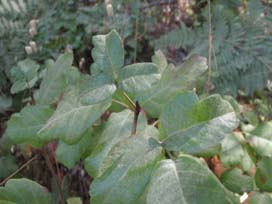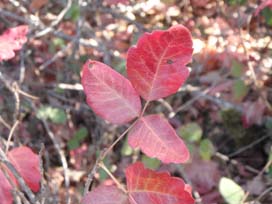







poison-oak
Toxicodendron diversilobum
Family: Anacardiacea
Type: Deciduous. Can be ground cover, vine, shrub or tree.
Branching: Alternate.
Leaves: Leaves are compound, usually with three leaflets per petiole. Blades vary from entire to deeply lobed, dark green (spring) to reddish (fall), oily (spring) to dull (fall).
Twig: Pale whitish-gray to light tan. Naked buds (no scales covering the bud). Terminal buds are long, white, and slightly furry, and stick up like a finger, a very distinctive field mark.
Fruit & Flower: Flowers hang in clusters. Fruit are small white drupes (like cherries, fleshy with a pit).
Miscellaneous: Showering in cold water with dish soap is the best way to prevent skin reactions. Rubbing alcohol can be used in the field to remove the oils from the skin. Poison-oak is shade-intolerant and limited by cold. It resprouts vigorously if cut or burned. Goats will control poison-oak by eating resprouts. All plants in Anacardiacea produce the same toxins; some people react badly to contact with the skins of mangoes, which are in Anacardiacea.
 |
 |
 |
 |
 |
 |
 |
 |